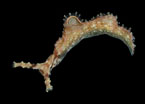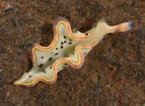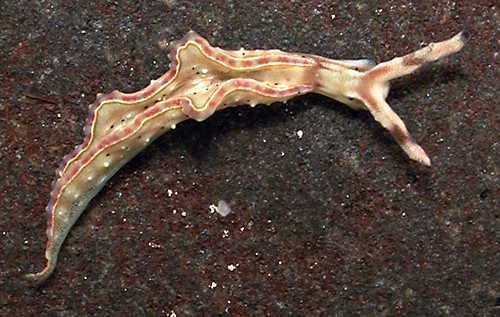_______________
Additional Photos

underside

strongly papillate

large spots

young, 2 mm
_______________
GALLERY

|
Elysia lobata Gould, 1852

Maximum size: 15 mm (Kay,
1979).
Identification:
This
species has a greenish-brown body densely frosted with minute
white flecks. Low, widely spaced, conical papillae cover its surface but
vary in development from "barely noticeable" to "prominent." The
parapodia form two or three broad chimneys and have widely scattered
black and white spots, the latter usually on the papillae. There is a
translucent pink marginal band punctuated with darker pink blotches and
a narrow
yellow submarginal line. Most animals have a narrow yellow-brown line
below the yellow one. The rhinophores have dark, irregular medial
bands and steel blue tips but one or both features may be absent.
Natural history:
Elysia lobata is a
moderately common plakobranchid found on shallow rocky bottoms. It
occurs
in moderately protected to moderately exposed locations at depths
of 1-2 m (3-6 ft). Mature animals are diurnally active and contract
their parapodia rhythmically while crawling. A 7 mm animal laid a light
cream egg mass of three whorls. It was 3 mm in diameter and the ribbon
was somewhat irregular in width.
Distribution:
Maui, Oahu and Kauai: also known from Japan and the Marshall
Islands.
Taxonomic notes:
Elysia lobata was
first reported from Hawaii in Gould, 1852. Elysia elsiae Ostergaard, 1955 is a
synonym. (Kay, 1979) It is also listed as Elysia sp. in Ostergaard, 1950.
Photo: CP: 8
mm: Hekili Point, Maui; March 30, 2006.
Observations and comments:
Note
1: ( )
|
|





